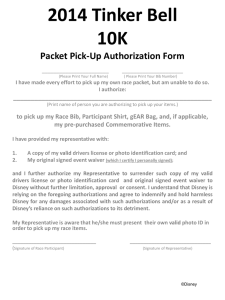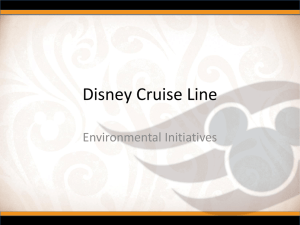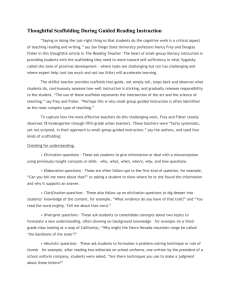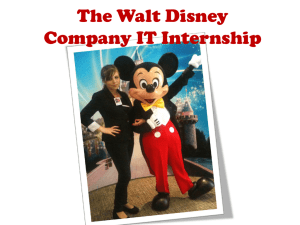case study approch - IIBMS, The Indian Institute Of Business
advertisement
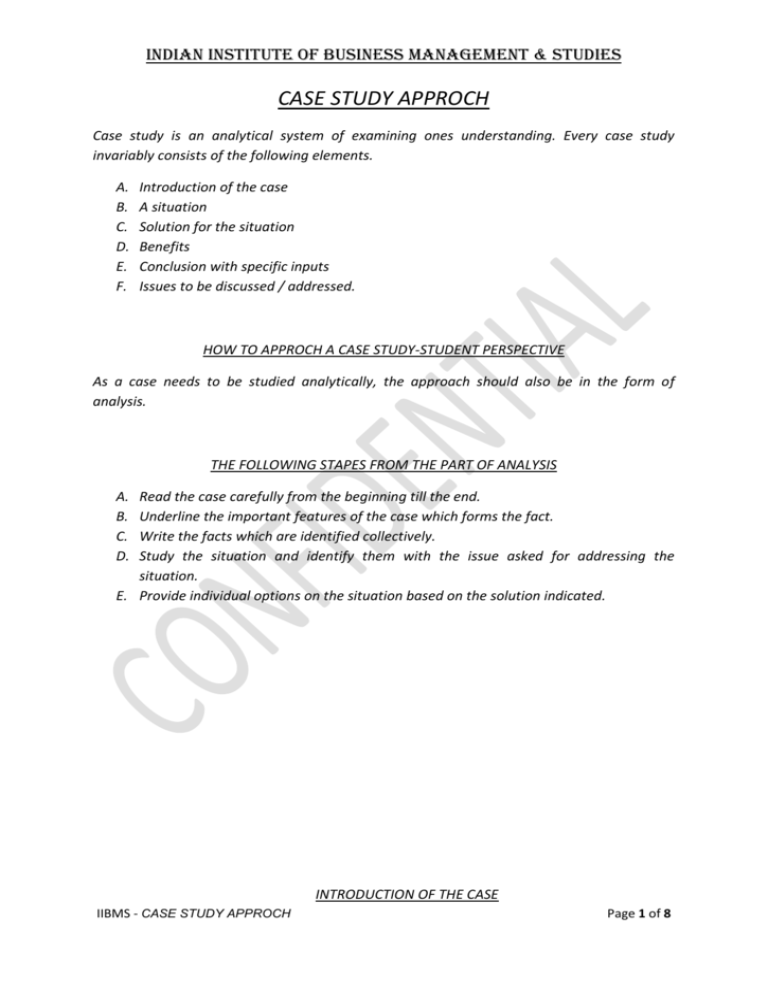
Indian Institute Of Business Management & Studies CASE STUDY APPROCH Case study is an analytical system of examining ones understanding. Every case study invariably consists of the following elements. A. B. C. D. E. F. Introduction of the case A situation Solution for the situation Benefits Conclusion with specific inputs Issues to be discussed / addressed. HOW TO APPROCH A CASE STUDY-STUDENT PERSPECTIVE As a case needs to be studied analytically, the approach should also be in the form of analysis. THE FOLLOWING STAPES FROM THE PART OF ANALYSIS A. B. C. D. Read the case carefully from the beginning till the end. Underline the important features of the case which forms the fact. Write the facts which are identified collectively. Study the situation and identify them with the issue asked for addressing the situation. E. Provide individual options on the situation based on the solution indicated. INTRODUCTION OF THE CASE IIBMS - CASE STUDY APPROCH Page 1 of 8 Indian Institute Of Business Management & Studies The Following case is dealing about the Tri-State Telephone Operation. Situation:John Godwin, chief executive of Tri-State Telephone, leaned back in his chair and looked at the ceiling. How was her ever going to get out of this mess? At last night’s public hearing. 150 angry customers had marched in to protest Tri-State’s latest rate request. After the rancorous shouting was over and the acrimonious signs put away, the protesters had presented state regulators with some sophisticated economic analysis in support of their case. Additionally, there were a number of emotional appeals from elderly customers who regarded phone service as their lifeline to the outside world. -------------------------------------------------------------------------------------------------------------------------SOLUTION Godwin’s company has recently proposed a new pricing system whereby users of local telephone services would simply pay for what they used rather than a monthly flat fee. All of the senior managers were convinced that the plan was fairer, even though some groups who used the phone with net able frequency (like real estate agents) would pay more. It would give the company an incentive to bring new services to their customer, and customers would be able to choose which ones to buy. -------------------------------------------------------------------------------------------------------------------------INPUTS Godwin himself believed the company should help its customers rather than fight with them. ISSUE TO BE ADDRESSED A. B. C. D. Facts of the case. Importance of stake holders. Why do you think Tri-State’s customers are so upset? Personnel opinion on the solution. OUTLINE OF QUESTION PATTERN THAN THE CASE STUDY APPROCHES A. Each question asked would be related to some specific situation. The student is expected to identify a case let related to that situation and answer the analyze the question accordingly. B. A case let is a short version of a case study. It may be a paragraph of about 10 to 20 lines with one or two questions for discussion. C. This approach is aimed at increasing the identification strategy of a person with respect to a specific situation and not at getting a direct answer to a question. Sample Case Study IIBMS - CASE STUDY APPROCH Page 2 of 8 Indian Institute Of Business Management & Studies DISNEY'S DESIGN The Walt Disney Company is heralded as the world's largest entertainment company. It has earned this astounding reputation through tight control over the entire operation: control over the open – ended brainstorming that takes place 24 hours a day; control over the engineers who construct the fabulous theme – park rides; control over the animators who create and design beloved characters and adventurous scenarios; and control over the talent that brings the many concepts and characters to life. Although control pervades the company, it is not too strong a grip. Employees in each department are well aware of their objectives and the parameters established to meet those objectives. But in conjunction with the predetermined responsibilities, managers at Disney encourage independent and innovative thinking. People at the company have adopted the phrase "Dream as a Team" as a reminder that whimsical thoughts, adventurous ideas, and all – out dreaming are at the core of the company philosophy. The over all control over each department is tempered by this concept. Disney managers strive to empower their employees by leaving room for their creative juices to flow. In fact, managers at Disney do more than encourage innovation. They demand it. Projects assigned to the staff "imaginers" seem impossible at first glance. At Disney, doing the seemingly impossible is part of what innovation means. Teams of imaginers gather together in a brainstorming session known as the "Blue Sky" phase. Under the "Blue Sky", an uninhibited exchange of wild, ludicrous, outrageous ideas, both " good" and " bad", continues until solutions are found and the impossible is done. By demanding so much of their employees, Disney managers effectively drive their employees to be creative. Current Disney leader Michael Eisner has established the "Dream as a Team" concept. Eisner realized that managers at Disney needed to let their employees brainstorm and create with support. As Disney president Frank Weds says, "If a good idea is there, you know it, you feel it, you do it, no matter where it comes from." Questions: IIBMS - CASE STUDY APPROCH Page 3 of 8 Indian Institute Of Business Management & Studies Q.1. What environmental factors influenced management style at Disney? Answer: The company being in the Entertainment Sector Huge size of the company Disney's Reputation Multi-continental nature of employee’s Diasporas Out-of-the Box Thinking Q.2 What kind(s) of organizational structure seem to be consistent with "Dream as a Team"? Answer: Decentralized Organization Liberated approach towards employee involvement Importance given to individual contribution throughout the company hierarchy Motivation given to natural inclinations of every employee faculties oriented towards the growth of company. Empowerment of Senior managers and inculcation of an appreciation system in recognition of efforts Q.3 How and where might the informal organization be a real asset at Disney? Answer: Reduction of stressful relationship dynamics amongst different levels of management Conduct of employees within these groups Identifying key behavioral rules Smoothening of implementation stage concerning social relations of the company Sample Case Study "THAT'S NOT MY JOB" – LEARNING DELEGATION AT CIN-MADE IIBMS - CASE STUDY APPROCH Page 4 of 8 Indian Institute Of Business Management & Studies When Robert Frey purchased Cin – Made in 1984, the company was near ruin. The Cincinnati, Ohi-based manufacturer of paper packaging had not altered its product line in 20 years. Labor costs had hit the ceiling, while profits were falling through the floor. A solid quarter of the company's shipments were late and absenteeism was high. Management and workers were at each other's throats. Ten years later, Cin – Made is producing a new assortment of highly differentiated composite cans, and pre-tax profits have increased more than five times. The Cin – Made workforce is both flexible and deeply committed to the success of the company. On-time delivery of products has reached 98 percent, and absenteeism has virtually disappeared. There are even plans to form two spin – off companies to be owned and operated by CinMade employees. In fact, at the one day "Future of the American Workforce" conference held in July 1993, Cin-Made was recognized by President Clinton as one of the best – run companies in the United States. “How did we achieve this startling turnaround?" Mused Frey. "Employee empowerment is one part of the answer. Profit sharing is another." In the late spring of 1986, relations between management and labor had reached rock bottom. Having recently suffered a pay cut, employees at Cin- Made came to work each day, performed the duties required of their particular positions, and returned home-nothing more. Frey could see that his company was suffering. "To survive we needed to stop being worthy adversaries and start being worthy partners," he realized. Toward this end, Frey decided to call a meeting with the union. He offered to restore worker pay to its previous level by the end of the year. On top of that, he offered something no one expected: a 15 percent share of Cin-Made's pre-tax profits. " I do not choose to own a company that has an adversarial relationship with its employees." Frey proclaimed at the meeting. He therefore proposed a new arrangement that would encourage a collaborative employee-management relationship “Employee participation will play an essential role in management." Managers within the company were among the first people to oppose Frey's new idea of employee involvement. "My three managers felt they were paid to be worthy adversaries of the unions." Frey recalled. It's what they'd been trained for. It's what made them good managers. Moreover, they were not used to participation in any form, certainly not in decision making." The workers also resisted the idea of extending themselves beyond the written requirements of their jobs. " (Employees) wanted generous wages and benefits, of course, but they did not want to take responsibility for anything more than doing their own IIBMS - CASE STUDY APPROCH Page 5 of 8 Indian Institute Of Business Management & Studies jobs the way they had always done them," Frey noted. Employees were therefore skeptical of Frey's overtures toward "employee participation." "We thought he was trying to rip us off and shaft us," explained Ocelia Williams, one of many Cin-Made employees who distrusted Frey's plans. Frey, however, did not give up, and he eventually convinced the union to agree to his terms. " I wouldn't take no for an answer," he asserted. "Once I had made my two grand pronouncements, I was determined to press ahead and make them come true." But still ahead lay the considerable challenge of convincing employees to take charge : I made people meet with me, then instead Of telling them what to do, I asked them. They resisted. " How can we cut the waste on his run ?" I'd say, or "How are we going to allocate the overtime on this order ?" "That's not my job," they'd say. "But I need your input," I'd say. "How in the World can we have participative management If you won't participate? "I don't know," they'd say. "Because that's not my job either. That's your job. ?" Gradually, Frey made progress. Managers began sharing more information with employees. Frey was able slowly to expand the responsibilities workers would carry. Managers who were unable to work with employees left, and union relations began to improve. Empowerment began to happen. By 1993, Cin Made employees were taking responsibility for numerous tasks. Williams, for example, used to operate a tin-slitting machine on the company's factory floor. She still runs that same machine, but now is also responsible for ordering almost $ 100,000 in supplies. Williams is just one example of how job roles and duties have been redefined throughout Cin-Made. Joyce Bell, president of the local union, still runs the punch press she IIBMS - CASE STUDY APPROCH Page 6 of 8 Indian Institute Of Business Management & Studies always has, but now also serves as Cin- Made's corporate safety director. The company's scheduling team, composed of one manager and five lead workers from various plant areas, is charged with setting hours, designating layoffs, and deciding when temporary help is needed. The hiring review team, staffed by three hourly employees and two managers, is responsible for interviewing applicants and deciding whom to hire. An employee committee performs both short – and long – term planning of labor, materials, equipment, production runs, packing, and delivery. Employees even meet daily in order to set their own production schedules. "We empower employees to make decisions, not just have input," Frey remarked. "I just coach." Under Frey's new management regime, company secrets have virtually disappeared. All Cin-Made employees, from entry-level employees all the way to the top, take part in running the company. In fact, Frey has delegated so much of the company's operations to its workers that he now feels little in the dark. "I now know very little about what's going on, on a day-to-day basis," he confessed. At Cin-Made, empowerment and delegation are more than mere buzzwords; they are the way of doing business – good business. "We, as workers, have a lot of opportunities," said Williams. "If we want to take leadership, it's offered to us." Questions and answers: Q.1 How were principles of delegation and decentralization incorporated into Cine – Made operations? IIBMS - CASE STUDY APPROCH Page 7 of 8 Indian Institute Of Business Management & Studies Answer :a. The employee participation was made an integral part of the company's management practices. b. Establishing Participative Management c. Centralized hiring process which was independent in itself and managed by designated managers. Q.2 What are the sources and uses of power at Cin – Made? Answer : Collaboration, Innovation, Participative management Empowerment through delegation and decentralization Deriving more output through employees' sense of ownership for their actions Improving flexibility of the companies' employees. Giving a free hand to their imagination rather than reining it in. Q.3. What were some of the barriers to delegation and empowerment at Cin –Made? Answer : Our perceptions about work and the way we are part of it need to change. These are the lessons in management that can be learnt from the Cin-Made experience. a. Transparent management policies are the call of the day b. Managers must lead by example rather than simply lecturing and ordering the employees. c. Any status quo achieved or stagnation point reached by way of policies being in place for long term must be challenged and remedied with cautious efforts; that to while taking care of sentimentalities and emotional attachments of old employees of company – all leading to change for the better. IIBMS - CASE STUDY APPROCH Page 8 of 8


